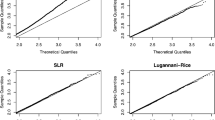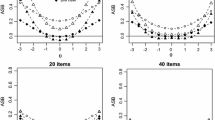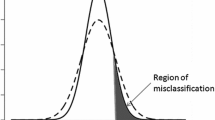Abstract
A mathematical definition of the theoretical relation between the examinee's actual responses to the test items and his “true ability” is selected. A maximum-likelihood solution is obtained for estimating the examinee's “true ability” from his responses to the items. The standard error of the maximum-likelihood estimate is obtained, its relation to the discriminating power of the test is pointed out, and some generalizations are drawn as to the optimum level of item difficulty. The Neyman-Pearson power function is applied to determine which of two psychological tests is the most powerful for the selection of “successful” examinees.
Similar content being viewed by others
References
Brogden, H. Variation in test validity with variation in the distribution of item difficulties, number of items, and degree of their intercorrelation.Psychometrika, 1946,11, 197–214.
Cronbach, L. J., and Warrington, W. G. Efficiency of multiple-choice tests as a function of spread of item difficulties.Psychometrika, 1952,17, 127–147.
Ferguson, G. A. Item selection by the constant process.Psychometrika, 1942,7, 19–29.
Finney, D. J. Probit analysis. Cambridge: Cambridge Univ. Press, 1947.
Green, B. F. Latent class analysis: A general solution and an empirical evaluation. Ph.D. thesis, Princeton University, 1951.
Guilford, J. P. Psychometric methods. New York: McGraw-Hill, 1936.
Gulliksen, H. The relation of item difficulty and inter-item correlation to test variance and reliability.Psychometrika, 1945,10, 79–91.
Gulliksen, H. Theory of mental tests. New York: John Wiley and Sons, 1950.
Lawley, D. N. On problems connected with item selection and test construction.Proc. roy. Soc. Edin., 1943,61-A, Part 3, 273–287.
Lawley, D. N. The factorial analysis of multiple item tests.Proc. roy. Soc. Edin., 1944,62-A, Part I, 74–82.
Lazarsfeld, P. F. (with S. A. Stoufferet al.). Measurement and prediction, Vol. 4 of studies in social psychology in World War II. Princeton: Princeton Univ. Press, 1950, Chs. 10 and 11.
Long, J. A., and Sandiford, P. The validation of test items. Bulletin No. 3, Department of Educational Research, University of Toronto, 1935.
Lord, F. M. A theory of test scores.Psychometric Monograph No. 7, 1952.
Lord, F. M. The relation of the reliability of multiple-choice tests to the distribution of item difficulties.Psychometrika, 1952,17, 181–194.
Lorr, M. Interrelationships of number-correct and limen scores for an amount limit test.Psychometrika, 1944,9, 17–30.
Mood, A. M. Introduction to the theory of statistics. McGraw-Hill, 1950.
Mosier, C. I. Psychophysics and mental test theory: fundamental postulates and elementary theorems.Psychol. Rev., 1940,47, 355–366.
Mosier, C. I. Psychophysics and mental test theory. II. The constant process.Psychol. Rev., 1941,48, 235–249.
Richardson, M. W. Relation between the difficulty and the differential validity of a test. Ph.D. thesis, University of Chicago, 1936. AlsoPsychometrika, 1936,1 (No. 2), 33–49.
Symonds, P. M. Choice of items for a test on the basis of difficulty.J. educ. Psychol., 1928,19, 73–87.
Thorndike, R. L. Personnel selection. New York: John Wiley and Sons, 1949, pp. 228–230.
Thurstone, T. The difficulty of a test and its diagnostic value.J. educ. Psychol., 1932,23, 335–43.
Tucker, L. R. Maximum validity of a test with equivalent items.Psychometrika, 1946,11, 1–13.
Tucker, L. R. A method for scaling ability test items in difficulty taking item unreliability into account.Amer. Psychologist, 1948,3, 309–10. (Abstract)
Wilks, S. S. Mathematical statistics. Princeton: Princeton Univ. Press, 1944.
Author information
Authors and Affiliations
Additional information
The author is indebteded to Dr. John W. Tukey for helpful comments on a draft of the present manuscript.
Rights and permissions
About this article
Cite this article
Lord, F.M. An application of confidence intervals and of maximum likelihood to the estimation of an examinee's ability. Psychometrika 18, 57–76 (1953). https://doi.org/10.1007/BF02289028
Received:
Revised:
Issue Date:
DOI: https://doi.org/10.1007/BF02289028




